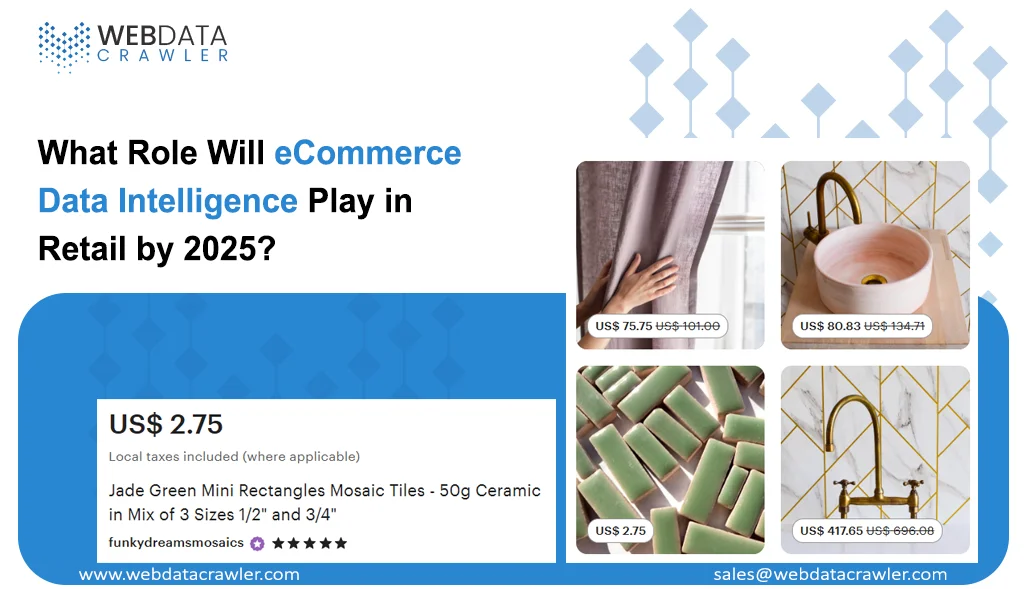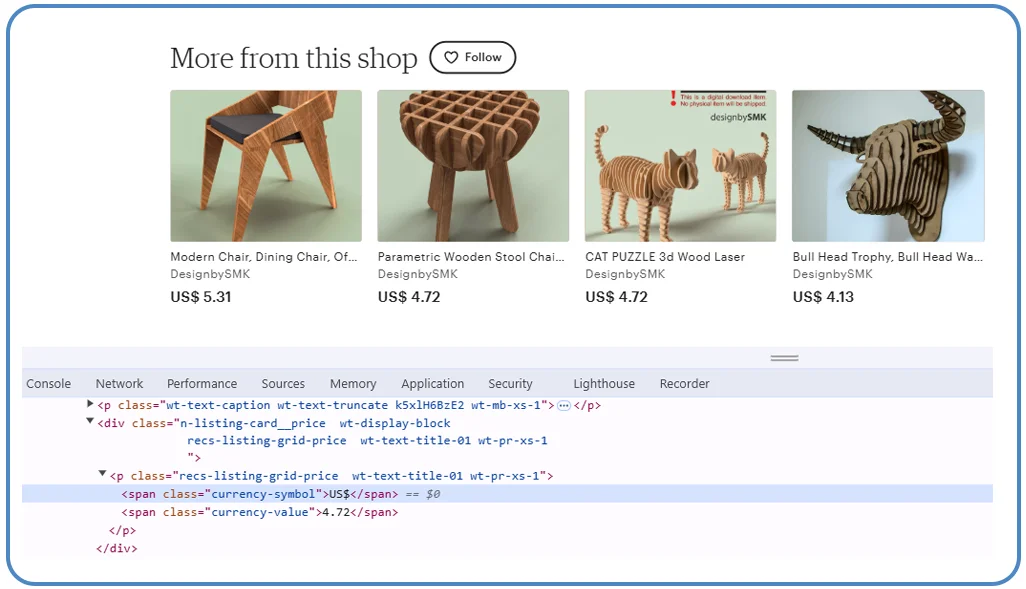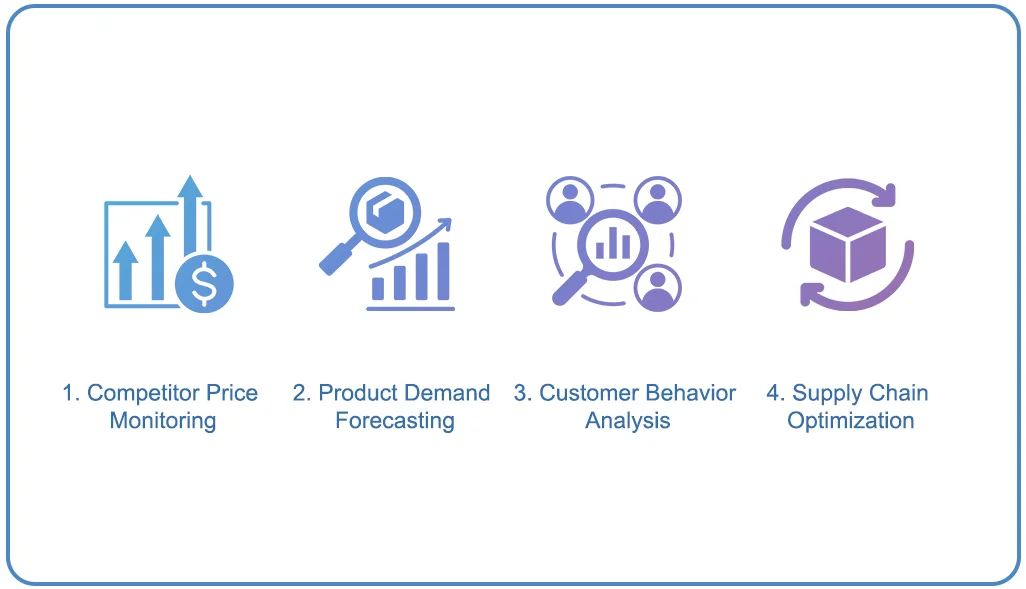What Role Will eCommerce Data Intelligence Play in Retail by 2025?
Jan 21

Introduction
The landscape of retail is evolving at an unprecedented pace, and at the heart of this transformation lies eCommerce data intelligence. As we approach 2025, eCommerce and retail businesses are increasingly relying on data to stay competitive and meet the expectations of the modern consumer. From personalized shopping experiences to optimized inventory management, retail data intelligence 2025 promises to revolutionize how businesses operate in the retail sector. In this blog, we’ll explore how eCommerce data intelligence is shaping the future of retail, its key use cases, and how Web Data Crawler can help businesses harness the power of data scraping to stay ahead of the curve.
The Rise of Data-Driven Retail Strategies

As technology continues to advance, retailers are turning to data to drive their decision-making processes. Data-driven retail strategies are not just a trend—they’re becoming essential for survival. By gathering insights from vast amounts of data, businesses can make more informed decisions on pricing, inventory, customer behavior, and marketing strategies.
In 2025, eCommerce trends retail 2025 will be heavily influenced by data intelligence. Retailers will utilize data to offer personalized experiences, improve supply chain operations, and better engage with customers. The integration of artificial intelligence (AI), machine learning (ML), and big data analytics will enhance the decision-making capabilities of retail businesses, enabling them to anticipate trends, improve customer loyalty, and optimize their operations.
What is eCommerce Data Intelligence?

At its core, eCommerce data intelligence refers to the use of data analytics tools and technologies to gain insights into various aspects of the eCommerce business. This includes understanding consumer behavior, tracking product performance, monitoring pricing strategies, and analyzing competitors. By leveraging data from multiple sources such as social media, websites, and customer interactions, retailers can make more informed decisions that drive growth and improve customer satisfaction.
eCommerce Data Scraping Services: A Key to Unlocking Data Insights

One of the primary ways retailers gather valuable data is through eCommerce Data Scraping Services. Web scraping, or data scraping, involves extracting large volumes of data from websites. This data can include product details, prices, reviews, and customer feedback, all of which are vital for retailers looking to stay competitive.
By using Web Scraping Retail Data, businesses can monitor competitors’ pricing strategies, identify consumer trends, and optimize their product assortments. This allows retailers to make real-time adjustments to their strategies, providing a competitive edge in a rapidly changing market.
The Future of Retail eCommerce in 2025

The future of retail eCommerce in 2025 will be characterized by a deeper reliance on data intelligence. As more consumers shift towards online shopping, the role of data in understanding and predicting their preferences will become even more critical. Key areas where data intelligence will play a pivotal role include:
- Personalized Shopping Experiences: Retailers will use data to create personalized recommendations for customers, improving their shopping experience and boosting conversion rates.
- Dynamic Pricing: By analyzing competitor prices and customer demand, retailers can adjust prices in real-time, ensuring they stay competitive without sacrificing profitability.
- Inventory Management: Data intelligence can help retailers optimize their inventory by predicting demand patterns and ensuring that the right products are available at the right time.
- Customer Retention: By understanding customer behavior and preferences, retailers can develop targeted marketing campaigns to increase customer loyalty and retention.
Retail Data Intelligence 2025: A Snapshot
| Metric | 2025 Projected Value |
|---|---|
| Global eCommerce Revenue | $7.4 trillion (up from $4.9 trillion in 2021) |
| Retailers Using Data for Personalization | 75% (up from 60% in 2023) |
| Mobile Commerce Share | 72% of global eCommerce sales |
| AI in Retail Adoption | 80% of retailers by 2025 |
These statistics show that eCommerce trends retail 2025 will be heavily influenced by data intelligence, with nearly every aspect of the retail business benefiting from the use of data.
Key Use Cases of eCommerce Data Intelligence

1. Competitor Price Monitoring
In a highly competitive eCommerce market, price monitoring is critical. Retailers can use eCommerce data scraping services to track the prices of similar products from their competitors. By scraping eCommerce product data, businesses can adjust their pricing strategies in real-time to ensure they remain competitive without overpricing or underpricing their products.
Example: A retailer selling electronics can scrape data from competing electronics websites to understand how their prices compare and make adjustments based on demand and competitor prices.
2. Product Demand Forecasting
Data intelligence enables retailers to predict product demand with greater accuracy. By analyzing historical sales data, current trends, and seasonal factors, retailers can forecast which products will be in demand and ensure they are adequately stocked.
Example: A grocery retailer can use data scraping to analyze regional demand for specific products, such as organic produce or dietary supplements, to optimize inventory and avoid overstocking or stockouts.
3. Customer Behavior Analysis
Understanding customer behavior is key to creating personalized marketing campaigns and improving conversion rates. By leveraging data intelligence, retailers can track customer interactions across websites, social media, and mobile apps to gain insights into their preferences, purchase patterns, and interests.
Example: An online fashion retailer can scrape social media data to understand the latest trends and tailor their product offerings and marketing campaigns to match customer preferences.
4. Supply Chain Optimization
Data intelligence can also help retailers optimize their supply chains by analyzing supplier performance, delivery times, and shipping costs. By scraping eCommerce product data and monitoring stock levels, businesses can streamline their operations and reduce overhead costs.
Example: A global retailer can scrape data from multiple suppliers to compare prices, delivery times, and quality, ensuring the most efficient and cost-effective supply chain.
Case Studies: Real-Life Applications of eCommerce Data Intelligence

Case Study 1: Amazon’s Price Optimization

Amazon has long been at the forefront of using eCommerce data intelligence to drive its pricing strategies. The company uses sophisticated algorithms to track competitor pricing, adjust its own prices dynamically, and ensure it stays competitive. Through data scraping and analytics, Amazon can respond to changing market conditions in real-time, optimizing prices for millions of products daily.
Case Study 2: Walmart’s Inventory Management

Walmart has leveraged retail data intelligence 2025 to optimize its supply chain and inventory management. By using predictive analytics, Walmart can forecast demand and adjust its inventory accordingly. This has allowed the company to reduce waste, increase efficiency, and ensure that popular products are always in stock.
How Web Data Crawler Can Help?

As the demand for eCommerce data scraping services grows, it’s essential for businesses to partner with reliable and efficient data scraping providers. Web Data Crawler is a leading service provider that helps businesses scrape eCommerce product data and web scraping retail data to gain valuable insights.
With Web Data Crawler, businesses can:
- Scrape eCommerce product data in real-time to monitor competitor prices, product availability, and market trends.
- Track price fluctuations and competitor strategies to adjust pricing dynamically.
- Monitor customer sentiment and product reviews to improve product offerings and marketing campaigns.
- Automate data extraction from multiple eCommerce platforms, saving time and improving data accuracy.
By utilizing Web Data Crawler’s powerful scraping solutions, businesses can harness the full potential of eCommerce data intelligence, enabling them to make smarter, data-driven decisions that propel growth and profitability.
Conclusion
As we approach 2025, eCommerce data intelligence will play a pivotal role in shaping the future of retail. From personalized shopping experiences to optimized pricing and inventory management, data will drive every aspect of the retail process. By leveraging Web Scraping Retail Data and eCommerce Data Scraping Services, businesses can gain valuable insights into customer behavior, market trends, and competitor strategies.
At Web Data Crawler, we offer the tools and expertise needed to scrape and analyze eCommerce data effectively. Ready to take your retail business to the next level? Contact us today to learn how we can help you harness the power of data intelligence!
Discover how Web Data Crawler can help you stay ahead of the competition—contact us now and unlock the future of data-driven retail!